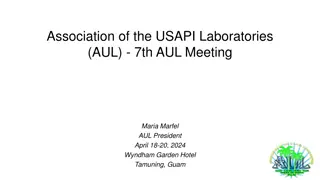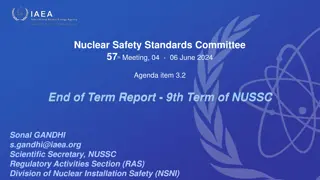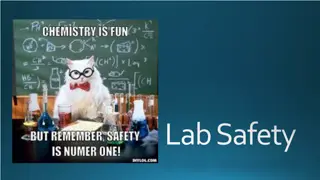Lab Safety
Lab Safety. Professor Lei Zhuu2019s Research Group 2013.10.09. Outlines. Lab Safety Training Eye Protection Lab Coat Gloves Fume Hoods CHP, ECP Emergency. 1. Lab Safety Training. You can work in the lab only after you finish the lab
Download Presentation

Please find below an Image/Link to download the presentation.
The content on the website is provided AS IS for your information and personal use only. It may not be sold, licensed, or shared on other websites without obtaining consent from the author.If you encounter any issues during the download, it is possible that the publisher has removed the file from their server.
You are allowed to download the files provided on this website for personal or commercial use, subject to the condition that they are used lawfully. All files are the property of their respective owners.
The content on the website is provided AS IS for your information and personal use only. It may not be sold, licensed, or shared on other websites without obtaining consent from the author.
E N D
Presentation Transcript
Lab Safety Professor Lei Zhu s Research Group 2013.10.09
Outlines Lab Safety Training Eye Protection Lab Coat Gloves Fume Hoods CHP, ECP Emergency
1. Lab Safety Training You can work in the lab only after you finish the lab safety training. Taking the training is the first thing you need to do if you want to work in the lab. The Lab Safety Training is available at EHS. Go to EHS or call them to schedule your training. Training is held from 2:30 to 4:30 on the second Wednesday of each month. You need do the retraining annually. The first time you need go to EHS personally. Afterwards, you can do the training online. EHS will send you an email for the retraining. You can find a lot of information on the EHS website. https://www.case.edu/ehs/
2. Eye Protection Eye protection is required when you work in the lab. There are mainly three types of eye protection: safety glasses, goggles, and face shields. 1. Safety Glasses -Safety glasses have shatter resistant lenes made of materials like polycabonate or propionate plastic with side shields attached to the side pieces. -Safety glasses are designed to stop large physical objects such as wood chips from injuring your eyes. They are also used to provide laser light filtration to prevent reflections from the laser entering the eye and causing retinal burns. Safety glasses provide little to no protection from liquids or vapors. 2. Face Shield -Face shields are designed to augment other types of eye protection and are not meant to be a stand alone form of eye protection. Face shields are used to protect your entire face with goggles on under the shield to catch any liquids that might have made it past the shield.
2. Eye Protection 3. Goggles -Goggles come in two different types, vented and non-vented. -Non-vented goggles are used to protect your eyes from vapors, mists, fumes, or other eye hazards when you have to cover your eyes completely but the material hazard does not require covering of all exposed skin. -Vented goggles are used where there are moderated quantities of liquids involved but no vapors or mists are involved. The vented goggles are the most commonly used in the lab. Purchase your own pair and mark your name on them. You can take a spare pair in the goggle basket near the door of lab or buy a new pair in the Fisher stock room in Chemistry Department. Details of the eye protection could be found here: https://www.case.edu/ehs/LabSafety/eye.html
3. Lab Coat LABORATORY COATS MUST BE WORN WHENEVER YOU ARE IN A LABORATORY The lab coat can not be worn in public area. You should take off your lab coat before you leave the lab. You can take a spare lab coat in the lab or buy a new one in the Fisher stock room in Chemistry Department. The lab coat will be cleaned regularly. Details of the lab coat could be found here: https://www.case.edu/ehs/LabSafety/coat.html
4. Gloves Choose the proper gloves when you work with chemicals. The gloves can not be worn in public area. Take off your gloves before you leave the lab. You can get the commonly used gloves in the Fisher stock room in Chemistry Department. Details of the gloves could be found here: https://www.case.edu/ehs/LabSafety/glove.html
5. Fume Hoods Run your chemical experiment under hoods. Keep chemical hood sashes closed when the hood is not in use. Details of the fume hoods could be found here: https://www.case.edu/ehs/LabSafety/hoods.html
6. CHP and ECP Read the Chemical Hygiene Plan (CHP) and the Exposure Control Plan for Biohazards (ECP), get yourself trained. Find the person in charge of the safety and then sigh the CHP and ECP. The paper copies of CHP and ECP should be kept in every labs. The CHP and ECP will be renewed every year.
7. Emergency Don t panic when an emergency (like fire) happens. Protect yourself first. Contact the PI, or the person in charge of the safety if necessary (their phone number should be listed on the door of the lab). Contact EHS 216-368-2907, or Call emergency 216-368-3333























